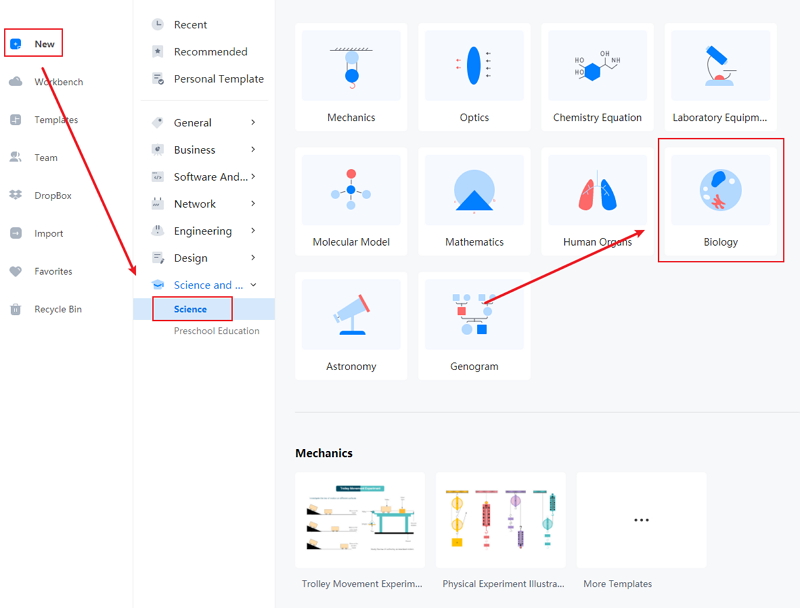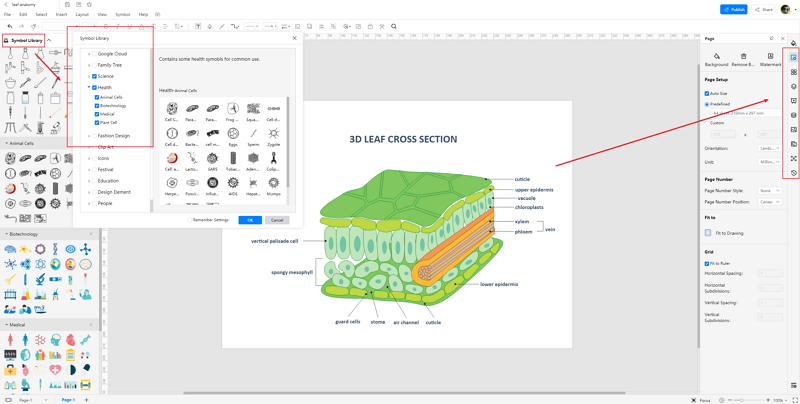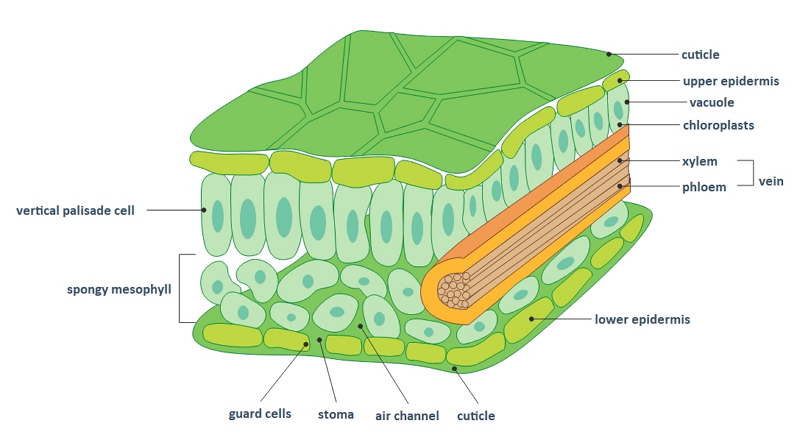A Guide to Understand Leaf with Diagram
Photosynthesis is the process that generates food for the plant, and leaves play a significant role in the process. They convert photon energy into chemical energy. The structure of the leaf contributes to the process. It also participates in the transportation of water and nutrients. Therefore, to understand the process, the students must learn the structure of leaves. They can use a leaf cross-section diagram for studying the parts but creating a diagram by hand is difficult. To avoid the situation, they must use a diagramming tool, which can help them create a high-quality leaf cross-section labeled diagram without any hassle.
1. What is the Leaf Cross Section?
Leaves are the powerhouse of plants as they prepare food by the process of photosynthesis. In the presence of water and carbon dioxide, the chlorophyll present in the leaves converts the energy of the sunlight into sucrose and water. The structure of the leaves helps in the regulation of the whole process. The cross-section of the leaves can show the cells present in the leaves. It also indicates how they assist in the process of photosynthesis. They also participate in the circulation of water and nutrients in the plant bodies.

2. The Structure of Leaf Cross Section
The leaf structure ensures the process of photosynthesis is conducted aptly, and hence the parts are conditioned to work accordingly.
- Vein:
Plant veins consist of the xylem and phloem. It participates in the water and food transportation process throughout the plant body.
Functions:
- The veins transport the water from the root to leaves and chloroplasts for the process of photosynthesis.
- They also work to transport the produced sucrose in different parts of a plant body for storage.
- Xylem and Phloem:
Xylem is plant tissues looking like tubes and mainly made of dead tissues. Phloem is plant tissue made of living cells and participates in transportation.
Functions:
- The primary function of the xylem is to transport the water and nutrients from the root to the leaves and other parts of a plant through xylem sap.
- Phloem works to transport the sucrose and amino acids to the places where they are stored.
- Vascular bundles:
The vascular bundles are vessel-like structures present in the stem and the leaves. And they have phloem located outside and a xylem on the inside.
Functions:
- As it has both xylem and phloem, it enhances the transportation of water and other solutes.
- Cuticle:
There is a thin waxy layer on the leaves, which is transparent and allows maximum light penetration. It is called the cuticle.
Functions:
- They prevent the evaporation of water through leaves.
- Palisade mesophyll:
They are large rod-shaped cells present near the surface of the leaves and have chloroplasts for photosynthesis.
Functions:
- As they have a high number of chloroplasts, they participate in photosynthesis. The intercellular gaps in palisade cells allow gaseous exchange.
- Spongy mesophyll:
These smaller cells (than the palisade cells) are present at the lower part of the leaves and contain very few chloroplasts.
Functions:
- They have air spaces that work for the diffusion of oxygen and carbon dioxide.
- Lower Epidermis:
They form a protective layer of cells a d has stomata. Some trees create a waxy layer named cuticle.
Functions:
- The lower epidermis has stomata and guard cells, and they combinedly work on the process of gaseous exchange and maintenance of water level.
- Stomata:
Stomata are small holes guarded with sausage-shaped cells which can open or close by changing shapes.
Functions:
- Evaporates the excess water when open.
- Closes to prevent water loss.
- Regulates the exchange of carbon dioxide and oxygen.
3. How to Draw the Leaf Cross Section Labeled
To understand the plant mechanism of water transportation and photosynthesis, the students must learn the structure of the leaves, and for that, they can use a lead cross-section diagram. However, it can be challenging to do it by hand. A student can follow these steps to make a leaf cross-section diagram:
3.1 How to Create Leaf Cross Section Labeled Diagram from Sketch
Creating such a diagram by hand can be difficult. The students can follow these steps to make their leaf cross-section labeled diagram:
Step 1: The students can draw two faint parallel lines and then add air spaces present above the stomata. Then they can substitute the straight lines with wavy patterns. They need to draw similar patterns on both sides. Their edges are joined to create barrel shapes for the epidermal cells.

Step 2: The students should draw an irregular elongated oval shape and border it with the barrel-shaped cells. It helps to make the vascular bundle in the middle. At the top part of the vascular bundle, hexagonal structures are made without leaving any space within them. They are xylem. Hence the students need to make their walls with thick lines. For phloem, they have to draw small hexagonal shapes.

Step 3: Then rod shapes are drawn from the upper epidermis without leaving any space in between them. There are several layers, and there are a few of them located under the vascular bundles. They can put dots on the rod shapes, which indicate the chloroplasts. These are palisade mesophyll cells.
Step 4: Students should also draw cells with similar rod-shaped structures with much space, and they are also dotted. It helps them to create spongy mesophyll. Once this completes, the students can neatly label the diagram.

3.2 How to Create Leaf Cross Section Labeled Diagram Online
The process of creating a leaf cross-section is challenging and can be time-consuming. The students may fail to create a high-quality diagram. For that, they must use the EdrawMax Online tool. It is user-friendly and can help the students to make the best leaf cross-section diagram. Here are a few easy steps which the students can follow to use this tool:
Step 1: EdrawMax Online tool is effortless to use, and hence anyone can work comfortably on this tool. To start with the process, the students need to open the EdrawMax Online tool. After that, they should open New. The students then have to click on the Science and Education tab.

Step 2: They can use this tool to draw different types of educational diagrams. It comes with a wide range of diagrams that the students can use as per their requirements. They need to select the Biology option and then find the leaf cross-section labeled diagram. They can modify it according to their choice.

Step 3: After selecting the template they require, the students should modify it as per their choice. The tool gives the students some hassle-free options to edit their diagrams. They can work on those images according to their preference to create a high-quality leaf cross section image.

Step 4: Once they complete their diagrams, they can save the image in multiple file formats. Then they can export the files to use in their lessons or projects.

4. Transpiration Stream
Transpiration occurs through the evaporation of water from the spongy mesophyll cells and stomata. The transpiration stream is responsible for the movement of water through the xylem.
Transpiration is the reason behind the pull created on the water on the xylem vessel. Due to the cohesive force of the water, it travels to the leaves and stems of the plants. This process also regulates the transportation of minerals and ions.
This process supplies the water to the plant for photosynthesis and, at the same time, maintains the turgidity. If the rate of transpiration increases, there is an increase in the absorption rate of the water as well. In case of damaged roots, these may cause wilt in the plant.

5. Conclusion
The leaf cross-section diagram can allow a student to have an idea about the structure of the leaves and the function of the cells present in them. It is easier to learn with the help of a diagram. The students can draw by hand, but the process is long and complicated. The students may not get satisfactory results. They must use the EdrawMax Online tool to create a good-quality leaf cross-section diagram.
In conclusion, EdrawMax Online is a quick-start diagramming tool, which is easier to make artery and vein diagram and any 280 types of diagrams. Also, it contains substantial built-in templates that you can use for free, or share your science diagrams with others in our template community.






